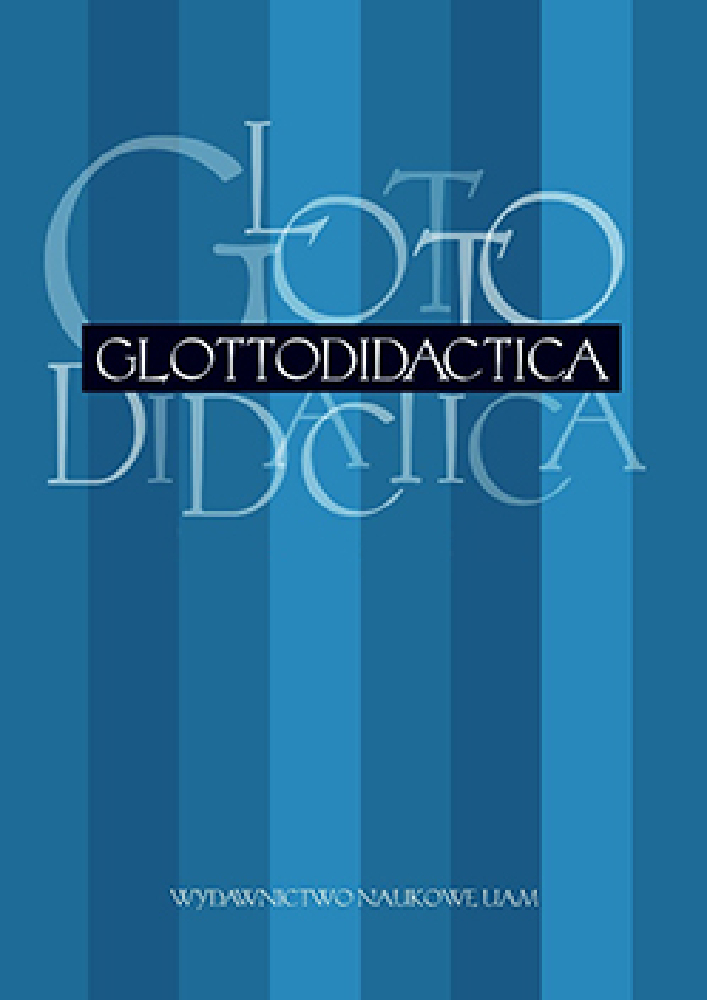Abstract
The aim of this paper is to discuss the role of turn-taking in dialogs of Polish and German schoolchildren aged from 13 to 15 years. The paper begins by describing the project and briefly viewing the most relevant definitions (e. g. turn, backchannels, segments). The next section presents the notation system and the methods. The samples were selected from the BORDERLAND data bank and, in total, they included nine pairs and over 1,000 segments. On this basis, it can be concluded that turn-taking in uniform pairs (Polish-Polish and German-German) is more defensive, and that the interlocutors tend to use more segments. There might also be a slight tendency for Polish speakers to interrupt their interlocutors more frequently. The findings, based on our samples, also suggest that speaking a foreign language (as we can notice in the German-Polish pairs) usually means less competitive speaking, as well as fewer segments and turn-takings
Literaturhinweise
Auer, P. / Selting, M. (2001). Der Beitrag der Prosodie zur Gesprächsorganisation. In: K. Brinker et al. (Hrsg.). Text- und Gesprächslinguistik. HSK 16.2. (S. 1122–1131). Berlin / New York: de Gruyter. DOI: https://doi.org/10.1515/9783110169188.2.17.1122
Brinker, K. / Sager, S. (2010). Linguistische Gesprächsanalyse. Eine Einführung. Berlin: Erich Schmidt Verlag.
Couper-Kuhlen, E. / Selting, M. (2018). Interanctional linguistics. Studying language in social interaction. Cambridge: Cambridge University Press.
Gravano, A. / Hirschberg, J. (2010). Turn-taking cues in task-oriented dialogue. Computer Speech and Language, 25 (2011), 601–634. DOI:10.1016 / j.csl.2010.10.003. DOI: https://doi.org/10.1016/j.csl.2010.10.003
Henne, H. / Rehbock, H. (2001). Einführung in die Gesprächsanalyse. 4. durchgesehene und bibliographisch ergänzte Auflage. Berlin / New York: de Gruyter. DOI: https://doi.org/10.1515/9783110906189
Karpiński, M. (2006). Struktura i intonacja polskiego dialogu zadaniowego. Poznań: Wydawnictwo Naukowe UAM.
Karpiński, M. / Czoska, A. / Jarmołowicz-Nowikow, E. / Juszczyk, K. / Klessa, K. (2018). Aspects of gestural alignment in task-oriented dialogues. Cognitive Studies / Études cognitives, 18. https://doi.org/10.11649/cs.1640 [Zugriff am: 1.08.2019]. DOI: https://doi.org/10.11649/cs.1640
Karpiński, M. / Klessa, K. (2018). Methods, tools and techniques for multimodal analysis of accommodation in intercultural communication. Computational Methods in Science and Technology, 24 (1), 29–41. DOI: https://doi.org/10.12921/cmst.2018.0000006
Klessa, K. (2016). Annotation Pro. Enhancing analyses of linguistic and paralinguistic features in speech. Poznań: Wydział Neofilologii Uniwersytet im. Adama Mickiewicza w Poznaniu.
Klessa, K. / Karpiński, M. / Wagner, A. (2013). Annotation Pro – a new software tool for annotation of linguistic and paralinguistic features. In: D. Hirst / B. Bigi (Hrsg.). Proceedings of the tools and resources for the analysis of speech prosody (TRASP) workshop (S. 51–54). Aix-en-Provence Labratoire: Parole et Langage.
Levinson, S. (2016). Turn-taking in human communication – origins and implications for language processing. Trends in Cognitive Sciences, January 2016, Vol. 20, No. 1, 6–14. http://dx.doi.org/10.1016/j.tics.2015.10.010 [Zugriff am: 31.08.2019]. DOI: https://doi.org/10.1016/j.tics.2015.10.010
Mroczynski, R. (2014). Gesprächslinguistik. Eine Einführung. Tübingen: Narr.
Rath, R. (2001). Gesprächsschritt und Höreraktivitäten. In: K. Brinker / G. Antos / W. Heinemann / S. F. Sager (Hrsg.). Text- und Gesprächslinguistik. HSK 16.2. (S. 1213–1226). Berlin / New York: de Gruyter. DOI: https://doi.org/10.1515/9783110169188.2.18.1213
Sacks, H. / Schegloff, E. / Jefferson, G. (1974). A simplest systematics for the organization of turntaking for conversation. Language, 50, 696–735. DOI: https://doi.org/10.1353/lan.1974.0010
Schmitt, R. (2005). Zur multimodalen Struktur von Turn-taking. Gesprächsforschung, 6, 17–61. www.gespraechsforschung.ozs.de [Zugriff am: 31.08.2019].
Selting, M. (1996). On the interplay of syntax and prosody in the constitution of turn-constructional units and turns in conversation. Pragmatics, 6, 3, 357–388.
Selting, M. (2000). The construction of units in conversational talk. Language in Society, 29 (4), 477–517. https://www.jstor.org/stable/4169050 [Zugriff am: 31.08.2019]. DOI: https://doi.org/10.1017/S0047404500004012
Wittenburg, P. / Brugman, H. / Russel, A. / Klassmann, A. / Sloetjes, H. (2006). ELAN: A professional framework for multimodality research. In: N. Calzolari / K. Choukri / A. Gangemi / B. Maegaard / J. Mariani / J. Odijk / D. Tapias (Hrsg.). Proceedings of the 5th Language Resources and Evaluation Conference (S. 1556–1559). Genoa: ELRA.
Lizenz
 Utwór dostępny jest na licencji Creative Commons Uznanie autorstwa – Bez utworów zależnych 4.0 Międzynarodowe.
Utwór dostępny jest na licencji Creative Commons Uznanie autorstwa – Bez utworów zależnych 4.0 Międzynarodowe.
Autorzy
Autorzy tekstów przyjętych do publikacji w czasopiśmie Glottodidactica są zobowiązani do wypełnienia, podpisania i odesłania na adres redakcji umowy o udzielenie nieodpłatnej licencji do utworów, z zobowiązaniem do udzielania sublicencji CC.
Zgodnie z umową, autorzy tekstów opublikowanych w czasopiśmie Glottodidactica udzielają Uniwersytetowi im. Adama Mickiewicza w Poznaniu niewyłącznej i nieodpłatnej licencji oraz zezwalą na użycie sublicencji Creative Commons Attribution-NoDerivatives 4.0 International (CC BY-ND 4.0).
Autorzy zachowują prawa do dalszego, swobodnego rozporządzania utworem.
Użytkownicy
Zainteresowani użytkownicy internetu uprawnieni są do korzystania z utworów opublikowanych od 2015 roku w Glottodidactica pod następującymi warunkami:
- uznanie autorstwa - obowiązek podania wraz z rozpowszechnionym utworem, informacji, o autorstwie, tytule, źródle (odnośniki do oryginalnego utworu, DOI) oraz samej licencji;
- bez tworzenia utworów zależnych - utwór musi być zachowany w oryginalnej postaci, nie można bez zgody twórcy rozpowszechniać np. tłumaczeń, opracowań.
Do wszystkich tekstów opublikowanych przed 2015 r. prawa autorskie są zastrzeżone.
Inne
Uniwersytet im. Adama Mickiewicza w Poznaniu zachowuje prawo do czasopisma jako całości (układ, forma graficzna, tytuł, projekt okładki, logo itp.).
Autorzy zachowują prawa do dalszego, swobodnego rozporządzania utworem.
Użytkownicy
Zainteresowani użytkownicy internetu uprawnieni są do korzystania z utworów opublikowanych od 2015 roku w Glottodidactica pod następującymi warunkami:
- uznanie autorstwa - obowiązek podania wraz z rozpowszechnionym utworem, informacji, o autorstwie, tytule, źródle (odnośniki do oryginalnego utworu, DOI) oraz samej licencji;
- bez tworzenia utworów zależnych - utwór musi być zachowany w oryginalnej postaci, nie można bez zgody twórcy rozpowszechniać np. tłumaczeń, opracowań.
Do wszystkich tekstów opublikowanych przed 2015 r. prawa autorskie są zastrzeżone.
Inne
Uniwersytet im. Adama Mickiewicza w Poznaniu zachowuje prawo do czasopisma jako całości (układ, forma graficzna, tytuł, projekt okładki, logo itp.).





